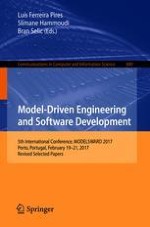This book constitutes thoroughly revised and selected papers from the 5th International Conference on Model-Driven Engineering and Software Development, MODELSWARD 2017, held in Porto, Portugal, in February 2017.
The 20 thoroughly revised and extended papers presented in this volume were carefully reviewed and selected from 91 submissions. They contribute to the development of highly relevant research trends in model-driven engineering and software development such as methodologies for MDD development and exploitation, model-based testing, model simulation, domain-specific modeling, code generation from models, new MDD tools, multi-model management, model evolution, and industrial applications of model-based methods and technologies.
